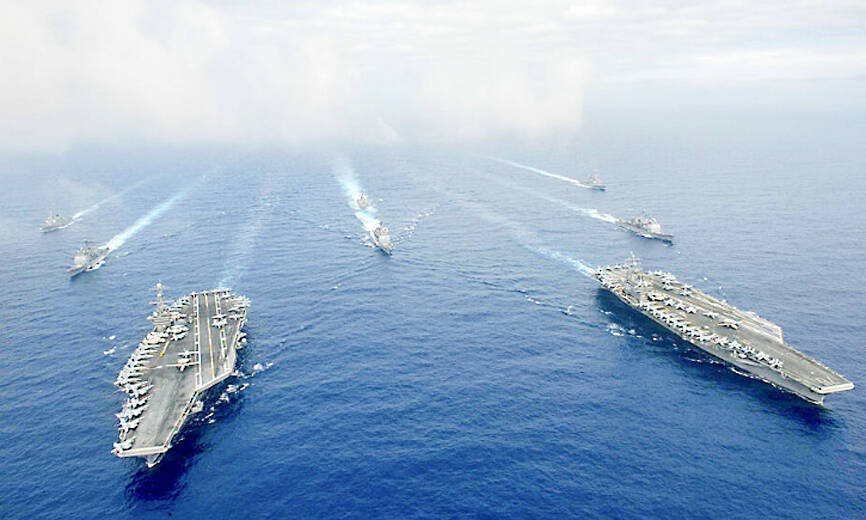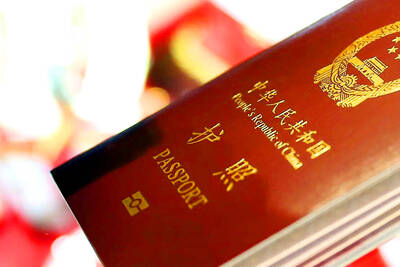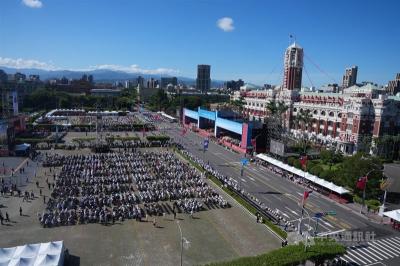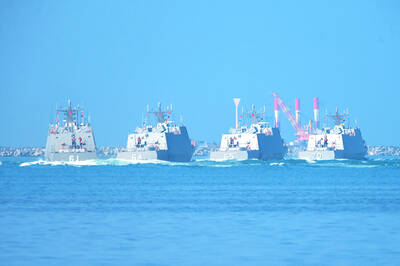US forces in the Pacific are increasing multinational military exercises in response to growing concerns about China’s aggression in the region, US Seventh Fleet Commander Vice Admiral Karl Thomas told the Washington Times.
To counter Beijing’s ambition of assuming greater control over the region, the US is focusing on “being forward and having many nations working together,” Thomas said in an interview published on Friday.
Based in Japan, the US Navy’s largest fleet is conducting more and larger exercises with more like-minded allies and partners, he said.

Photo: Jake Greenberg / US Navy / Handout via Reuters
The fleet — which includes 50 to 70 ships and submarines, 150 aircraft and more than 27,000 sailors and marines — has conducted more than 37 military drills in a region that stretches from the Northern Territories in Japan and the Russian-held Southern Kuriles, west to the Indian Ocean and south to Antarctica, the article said.
In addition to the US Navy, the US Marine Corps, US Army and US Air Force have carried out more operations with allied countries, including joint patrols in the disputed South China Sea and East China Sea with French and Canadian warships, it said.
The Australian Army, for the first time as a full partner after 10 years of observation, joined the US Army and the Japan Ground Self-Defense Force in the annual Yama Sakura military exercise earlier this month, the US Indo-Pacific Command said.
The exercise enabled the alliance to enhance its deterrence and response capabilities in the region by building interoperability, it said.
More countries in the region — including Indonesia, Malaysia, Sri Lanka and island nations in the Pacific — are “rejecting neutrality and choosing to work more closely with the US,” rather than keeping their distance from the tensions between Washington and Beijing, the Washington Times said.
The increase in military drills reflects “a new US reassurance of allies worried about China,” it said.
Miles Yu (余茂春), director of the China Center at the Hudson Institute and a former adviser on China policy to the US Department of State, told the newspaper that more operations are needed to ward off Chinese maritime aggression.
“It is essential we continue and strengthen our exercises and operations in international commons such as the South China Sea and the Taiwan Strait, and do it multilaterally, more frequently, with bigger vessels and joint flotillas of navies of like-minded countries, including NATO allies, but especially the primary victims of China’s relentless maritime bullying and harassment in the region,” Yu said.
Regarding recent conflicts between China and the Philippines at the Second Thomas Shoal (Renai Shoal, 仁愛暗沙), Thomas said that China is ramping up its “gray zone” tactics to seek illegal control over the Spratly Islands (Nansha Islands, 南沙群島), of which the shoal is a part and is also claimed by Taiwan.
Chinese behavior “causes all of us [nations in the region] concern, and we’re watching very closely,” he said.
Chinese state media have criticized the increase in military exercises by the US and its partners, which US officials say might be an indication that “Beijing is getting the strategic message,” the Washington Times report said.

The Ministry of the Interior (MOI) is to tighten rules for candidates running for public office, requiring them to declare that they do not hold a Chinese household registration or passport, and that they possess no other foreign citizenship. The requirement was set out in a draft amendment to the Enforcement Rules of the Public Officials Election and Recall Act (公職人員選舉罷免法 ) released by the ministry on Thursday. Under the proposal, candidates would need to make the declaration when submitting their registration forms, which would be published in the official election bulletin. The move follows the removal of several elected officials who were

The Republic of China (ROC) is celebrating its 114th Double Ten National Day today, featuring military parades and a variety of performances and speeches in front of the Presidential Office in Taipei. The Taiwan Taiko Association opened the celebrations with a 100-drummer performance, including young percussionists. As per tradition, an air force Mirage 2000 fighter jet flew over the Presidential Office as a part of the performance. The Honor Guards of the ROC and its marching band also heralded in a military parade. Students from Taichung's Shin Min High School then followed with a colorful performance using floral imagery to represent Taiwan's alternate name

FOUR DESIGNATED AREAS: Notices were issued for live-fire exercises in waters south and northwest of Penghu, northeast of Keelung and west of Kaohsiung, they said The military is planning three major annual exercises across the army, navy and air force this month, with the navy’s “Hai Chiang” (海強, “Sea Strong”) drills running from today through Thursday, the Ministry of National Defense said yesterday. The Hai Chiang exercise, which is to take place in waters surrounding Taiwan, would feature P-3C Orion maritime patrol aircraft and S-70C anti-submarine helicopters, the ministry said, adding that the drills aim to bolster the nation’s offshore defensive capabilities. China has intensified military and psychological pressure against Taiwan, repeatedly sending warplanes and vessels into areas near the nation’s air defense identification zone and across

A Chinese takeover of Taiwan would severely threaten the national security of the US, Japan, the Philippines and other nations, while global economic losses could reach US$10 trillion, National Security Council Deputy Secretary-General Lin Fei-fan (林飛帆) wrote in an article published yesterday in Foreign Affairs. “The future of Taiwan is not merely a regional concern; it is a test of whether the international order can withstand the pressure of authoritarian expansionism,” Lin wrote in the article titled “Taiwan’s Plan for Peace Through Strength — How Investments in Resilience Can Deter Beijing.” Chinese President Xi Jinping’s (習近平) intent to take Taiwan by force